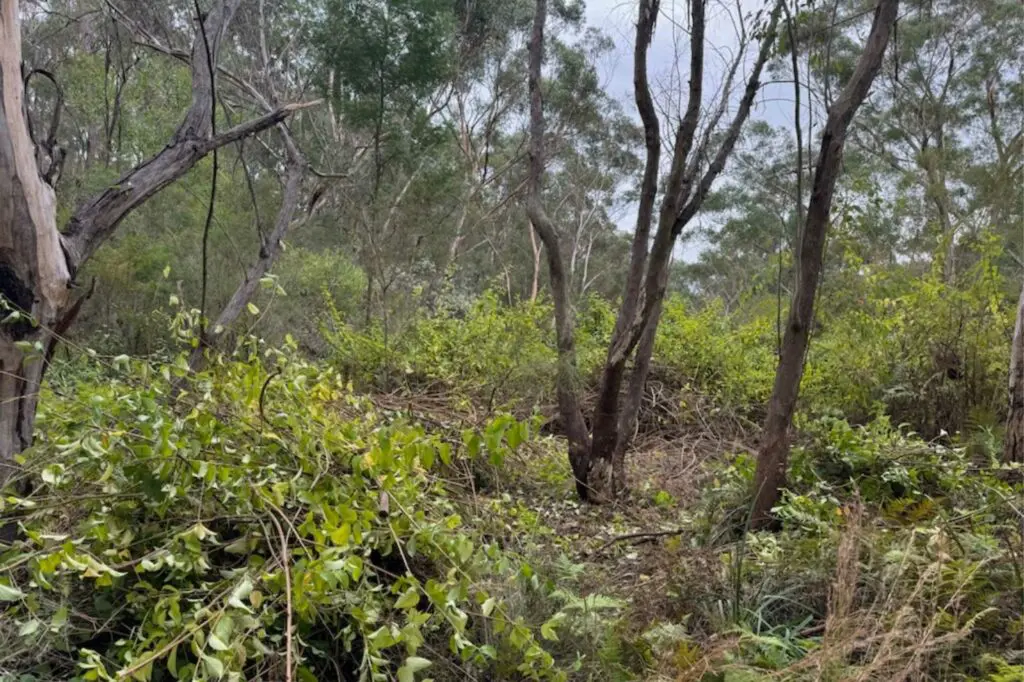Why was a Vegetation Management Plan Needed?
Vibe Health Clubs engaged the Habitat Solutions team to implement a Vegetation Management Plan (VMP) at their site in Annangrove. They needed a Vegetation Management Plan (VMP) completed for the restoration and management of critically endangered native plant communities.
The site contained two key Plant Community Types (PCTs), Cumberland Shale-Sandstone Ironbark Forest and Sydney Hinterland Grey Gum Transition Forest. These native ecosystems were under threat from weed species that were invading the site.
Loss of Biodiversity: The invasion of non-native species, particularly the presence of weeds like Lantana, Asparagus fern, and Bridal Creeper, threatens the biodiversity of the area. These invasive species outcompete native flora, leading to a reduction in native plant populations and a subsequent decline in the habitat quality for native fauna.
Degradation of Critically Endangered Communities: The site includes critically endangered ecological communities like the Cumberland Shale-Sandstone Ironbark Forest. The degradation of these communities due to invasive species and improper land management practices can lead to further endangerment and possible loss of these unique ecosystems.
Disruption of Ecological Processes: Invasive species can alter soil composition, water availability, and fire regimes, disrupting the natural ecological processes that sustain native plant communities. This disruption can lead to a decline in ecosystem resilience, making it harder for native species to recover and thrive.
Impact on Threatened Species: The site is home to threatened species, such as certain Epacris species. The spread of invasive species poses a direct threat to these plants by encroaching on their habitat and competing for resources.



Our team set about completing immediate restoration activities to protect these native ecosystems.
The immediate restoration activities the Habitat Solutions team completed as part of the Vegetation Management Plan included:
- Targeted weed treatment, with specific invasive species like Lantana, Asparagus fern, and Bridal Creeper identified as priorities for removal. The infestations were significant, with the weeds well establish and densely populated. Careful removal and management was essential to prevent regrowth.
- Prioritisation of significant weed species to reduce the existing weed seed bank on-site and prevent further spread. With a substantial seed bank present, ongoing monitoring and repeated treatment was a must.
- Exotic grasses and other non-native species were slashed, raked, removed, and sprayed across various zones to prepare the site for native planting.
- Revegetation efforts including native tubestock planting and assisted regeneration. Thousands of native tubestock plants were supplied, installed, and maintained across different zones of the site to restore native vegetation. Soil stabilizers were used to enhance plant establishment. Assisted regeneration efforts were conducted around threatened species such as Epacris, providing additional support to these vulnerable plants. Delicate handling of the Epacris was essential.
- The installation of irrigation systems was then completed to ensure the successful establishment of the newly planted native species, particularly during the initial stages of restoration.
- Monthly maintenance visits were scheduled to manage weed regrowth and support the ongoing health of the native vegetation.
- Fire risk mitigation work was also completed, with actions taken to reduce standing fuel loads and ensure safe access to the site. The team worked to find a balance between vegetation removal and conservation goals.


Long-term management activities are being completed on-site.
These include ecological monitoring works, as well as the installation of fencing and signage.
Annual Ecological Monitoring Reports: Regular monitoring and reporting has been implemented to track the effectiveness of the restoration efforts and the Vegetation Management Plan. These reports include evaluations of site conditions, treatment outcomes, and recommendations for future management.
Condition Mapping: Before and after condition maps have been created to visually document changes in weed density and native vegetation resilience over time.
Delineation Fencing: Fencing has been installed to delineate Asset Protection Zones (APZs) and areas containing threatened species, with appropriate signage to inform and protect these areas.
Boundary Delineation: Star pickets and other boundary markers have been installed to clearly define the management areas and prevent unintentional disturbances.


Benefits to the environment through this Vegetation Management Plan.
There are numerous benefits to the environment through the delivery of this Vegetation Management Plan.
Habitat Solutions Business Manager Joel Hall explains, “not only are we protecting the threatened plant species present on site, but we are ensuring the restoration of native ecosystems and improving biodiversity and habitat”.
“This also means enhanced ecological resilience”, he explains. “A broader range of wildlife, including pollinators, birds, and other native species, will be present in the area, contributing to the overall ecological resilience.”
The restored native vegetation will also be more resilient to environmental stressors such as drought, fire, and future weed invasions. This resilience is critical for the long-term sustainability of the ecosystem, allowing it to recover more quickly from disturbances and maintain its ecological functions.
If you’d like to learn more about our ecological consulting services, click here. Alternatively, if you’d like to get started on a Vegetation Management Plan, you can contact us here.

